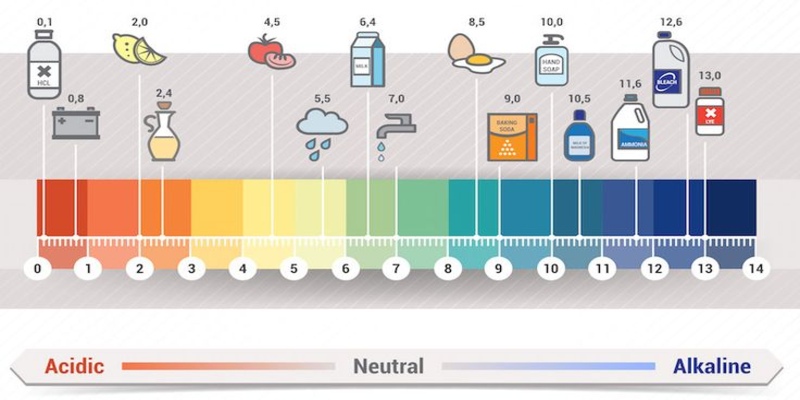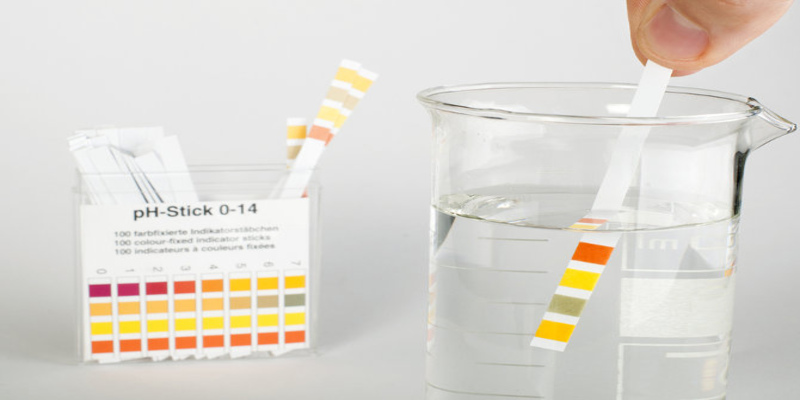The concept of pH represents "potential hydrogen." It is a phrase used to characterize a substance's acid-alkaline ratio. The pH scale operates in the 1–14 range. The highest acidity would be a pH of 1.
An alkaline (basic) pH of 14 would be the highest. The pH of your skin has a significant impact on the general health of your skin. In the middle of the pH range, our skin appears and works at its best.
5.5 is the perfect number. However, what is "skin pH" exactly, and how to find out your skin's pH level? We're going to answer that today!
Your Skin And pH

Your skin has a protective layer called the acid mantle. It's made of special acids that help keep your skin hydrated and safe from germs and dirt.
The acid mantle works best when it's a little acidic, around pH 5.5. But keep in mind that if it becomes too alkaline (less acidic), your skin can become dry and sensitive, or in a worst-case scenario,
You would even face eczema. Also, when your skin is too alkaline, it can't fight off certain enzymes that break down collagen, which makes your skin loose and wrinkly.
Research has shown that, unlike people with acidic skin, people with more alkaline skin tend to have wrinkles and sun damage.
On the other hand, if your skin is too acidic, it is also not a good sign. Your skin becomes itchy and might also cause skin breakouts and acne. In addition, when the acidity of your skin drops below 4.5, your skin can turn red and irritated.
How Do You Test Your Skin's pH Level?

Testing the pH of your skin is a difficult task. Usually, you would need to go to a dermatologist or other healthcare professional who uses a pH meter to measure the pH of your skin in order to receive an accurate response.
But here is the good news: there is no need for you to go anywhere because now here is how to test skin pH at home. Answer these eight short questions to help you figure out what pH level your skin is at.
How Does Cleansing Feel on Your Skin?
a) Silky and smooth texture
b) Tight and dry
c) Little oily or not wholly cleaned
How Frequently Do You Apply Facial Moisturizer?
a) Every morning and evening, at the very least
b) Once daily
c) Never
Has the Sensitivity of Your Skin to Everyday Goods, Such As Creams and Makeup, Increased?
a) No, it feels consistent and typical.
b) Occasionally
c) Yes, it seems to react to everything I put on it.
How Often Do You Have Dry, Flaky, and Rough Areas on Your Skin?
a) Occasionally
b) Never
c) Usually
Do You Find that in the Morning, Your Skin Appears More Lifeless and Wrinkled?
a) Not at all
b) Usually yes
c) Extremely uncommon
Is Your Skin Now Very Greasy and Prone to Breakouts, Unlike Before?
a) No
b) Occasionally
c) Yes
Do Redness and Irritation Frequently Appear on Your Skin?
a) No
b) It stings only after using items.
c) Yes
Does Your Skin Appear Hydrated, Dewy, and Plump?
a) Almost always
b) Sometimes
c) It's healthy but more oily than dewy
How Did Your Skin Score?

Your skin's pH is too high if the majority of your answers were B's:
Your skin type is alkaline or basic. Bacteria, UV radiation, and harsh substances are destroying the protecting lipids in your skin's acid mantle. Examine carefully the items you are using to cleanse, exfoliate, and moisturize your face. For a pH-balanced face cleanser, try Nayelle's mild cleanser. In addition, our pH-neutral HYDRATE Probiotic Moisturizing Cream and REJUVENATE Anti-Aging Night Cream are designed to help your skin reach its ideal pH balance.
Your skin's pH is ideal if the majority of your responses were A's:
It is a beautiful place for your skin. Well done; having skin this good is no coincidence. We are aware that you are utilizing the proper products when you wash and exfoliate.
If the majority of your answers were C’s:
Your skin is overly acidic, resulting in breakouts, irritation, and greasy skin. You may be using too many peeling products (think acids) to remove more grease. Your skin is suffering from too much of a good thing, even though this kind of exfoliation can contribute to a healthy complexion. You can be depending too much on exfoliating creams and face cleansers.
Other Options for Testing the pH Level of Your Skin
It is challenging to test the pH of skin on face directly, as we have previously discussed. You would need to speak with a dermatologist or other healthcare professional who uses a pH meter.
According to several dermatologists, the most straightforward technique to determine the pH level of your skin is to observe how it acts.
Check the pH of Your Saliva
The pH balance of your skin can be estimated from your body's pH level. A saliva test is a simple method. Consider utilizing pH ion balance strips. To get an instantaneous reading of your internal pH within 0.25 increments, dip a strip into your saliva.
Personal Testing Strips
You can figure out your skin's pH on your own with the use of at-home pH kits. They take the shape of paper strips that are measured and put on your skin.
Invest in skin-specific pH kits for optimal outcomes. Tests on your urine can determine the pH levels of your body, but they won't reveal the pH of your skin's surface.
Tests performed by a skincare expert can provide more accurate results than home kits.
through a dermatologist,
In-office pH testing is another service that dermatologists may provide. They can also assist you with cosmetics and other skin-related services that you may find helpful.
Watch And Measure
By closely observing your skin, you can determine the pH level in general. Skin that seems healthy and lacks dry patches may be categorized as balanced. Redness, irritation, acne, and dry patches can all be indicators of an alkaline, or high pH, skin type.
Conclusion
That is all you need to know about how to find out your skin's pH level.? If you want your skin to be healthy, then it involves more than just its pH level. You need to use the right cleanser and moisturizer for your skin type to keep your skin balanced and hydrated.
Also, don't forget to apply sunscreen every day to protect your skin from the sun and pollution. If you have any skin concerns, like redness or pimples, it's best to consult a dermatologist.
They can give you advice and treatments to keep your skin in good shape and deal with any issues you might have. Hopefully, now you know how to find out your skin's ph level at home.

Unlocking the Benefits of Stretching
Dec 31, 2023

Discover how magnesium can benefit your health and well-being, from improved sleep quality to reducing stress levels.
Jan 29, 2024

Achieve Optimal Fitness: Tips for Losing Fat and Building Muscle
Jan 04, 2024

Ensuring Water Safety: Steps to Prevent Drowning – Adults and Kids
Nov 03, 2023

How Are Allergies Treated? Your Comprehensive Guide
Jan 15, 2024

Heatwaves and Heart Health: The Rising Cardiac Risks
Dec 09, 2023

Unveiling Fresh Routes for Myasthenia Gravis Management
Nov 01, 2023

How To Regain Control Of Your Night Snacking
Feb 12, 2024



